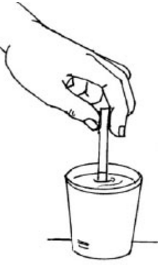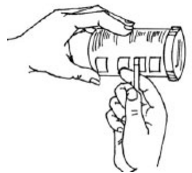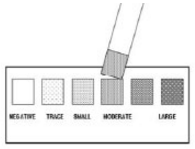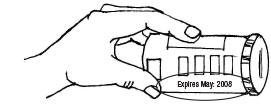High Blood Glucose (Hyperglycemia) and Ketones
Hyperglycemia (said like: hi per glie SEE mee ah) is also called high blood glucose. It happens when blood glucose numbers are higher than 120 mg/dl.
What Causes High Blood Glucose?
- Eating more carbohydrates than you calculated for your insulin dose
- Not enough insulin is taken
- Stress
- Illness
How do I Prevent High Blood Glucose?
- Count your carbohydrate closely.
- Give the right insulin dose based on your meal and blood glucose number.
- Change the insulin doses when you see a pattern of high blood glucose levels.
- Give insulin for all the carbohydrate you eat.
How will I Feel when My Blood Glucose is High?
-
Thirsty
-
Need to go to the bathroom a lot
-
Need to get up at night to go to the bathroom
-
Tired
-
Dry lips and mouth
What Should I do if My Blood Glucose is High?
- Drink fluids that do not have carbohydrates. Try to drink 1 full glass (8 ounces) every 30 to 60 minutes.
- Use the high blood glucose correction dose.
- Check your urine or blood for ketones if blood glucose is higher than 300 mg/dl.
- The body starts to use fat for energy.
- Ketones are made when fat is used for energy.
- Ketones are in the blood and in the urine.
- Ketones are acids.
- _________________________________________________________
- _________________________________________________________
- Collect urine in a cup.
- Dip the test strip into the cup (Picture 1).
- Remove the test strip from the urine.
- Wait 15 seconds.
- Match the color on the strip to the colors on the bottle (Picture 2 and 3).
- Check the expiration date on the bottle of test strips. Do not use them if it is past the date.
- Once the ketone bottle is opened, get new ketone test strips after 6 months.
- Keep the ketone test strips in the bottle that they come in with the lid on.
- If you have small ketones, give 5% (0.05) of your Lantus® dose.
- If you have moderate or large ketones, give 10% (0.1) of your Lantus® dose.
- 20 x 0.05 = 1, so:
- Give 1 unit of Humalog® or Novolog® for small ketones.
- 20 x 0.1 = 2, so:
- Give 2 units of Humalog® or Novolog® for moderate or large ketones.
- Meal bolus
- Correction bolus
- Ketone bolus
- Sick day when you are able to drink.
- Sick day when you are vomiting and not able to drink.
- Fast breathing
- Fruity smell to the breath
- Hard to wake up
- Feeling sick to the stomach (nausea) or having belly pain
- Check ketones if blood glucose is higher than 300 mg/dl and when you are sick.
- Give the right amount of ketone bolus if you have small, moderate, or large ketones.
- Call the Endocrinology office or doctor on call when:
- You have used a ketone bolus for moderate or large ketones twice and your ketones are still moderate or large.
- You have treated a low blood glucose twice and your blood glucose is still low.
- You have thrown up (vomited) 3 times.
- DKA is dangerous!!
- When you have signs of DKA, you need to act quick by:
- Calling the endocrinology office or doctor on call,OR
- Going to the local emergency department.
|
High blood glucose, by itself, is not an emergency. High blood glucose and small, moderate, or large ketones IS something you should take care of right away. |
Why would I Have Ketones?
You need glucose in every cell in your body to use for energy. Your body needs glucose and insulin in your blood. When there is not enough glucose or not enough insulin, your cells will not have glucose to use for energy.
When Cells do not Have Glucose to Use for Energy:
What 2 things does Your Body Need to Prevent Ketones?
How do I Check for Ketones?
NOTE: There are some blood glucose meters that are able to measure ketones in a drop of blood if using a special test strip specific to check ketones.



Picture 1 Picture 2 Picture 3
Tips

What do I do if I Have Ketones that are Small, Moderate, or Large?
You will need more rapid-acting insulin (Humalog®, Novolog®, or Apidra®).
This is called a ketone bolus.
A Ketone Bolus is:
Based on your daily Lantus® basal dose or your total daily basal insulin dose on your pump.
Dose is based on Lantus® dose, but use Humalog®/Novolog® for ketone bolus.
Example: Your daily Lantus dose is 20 units.
Your rapid-acting insulin dose at that time will have three parts:
All three bolus doses are added together to equal the rapid-acting insulin dose.
What is your Lantus® insulin dose?
________________________________________________________
What is 10% of your Lantus® insulin dose?
________________________________________________________
What is your ketone bolus dose for small ketones?
________________________________________________________
What is your ketone bolus dose for moderate or large ketones?
________________________________________________________
Use one of the following flow sheets that most closely fits your symptoms:
|
Important to Remember Do not exercise if you have ketones that are small, moderate, or large. |
Are Ketones a Problem?
Ketones can make you very sick. When there are ketones in the blood, the blood can become acidotic. This is called Diabetic Ketoacidosis (DKA).
Signs of Ketoacidosis:
|
Important to Remember if You Have Ketones |
| If signs of ketoacidosis are present, contact the Diabetes Center rightaway or go to your local emergency department. |
| If you have ketones, check your blood glucose and ketones every 3 hours. |
| Give a ketone bolus every 3 hours until ketones are negative. |
| Keep eating carbohydrates and take extra Humalog®/Novolog® with meals (ketone bolus). |
| Take the same dose of long-acting Lantus® insulin that you usually take. |
| Drink 1 full cup (8 ounces) of water every 30 to 60 minutes. |
How do I Prevent Diabetic Ketoacidosis (DKA)?
Important to Remember
Back to the Managing Your Diabetes Resource Book Table of Contents »
